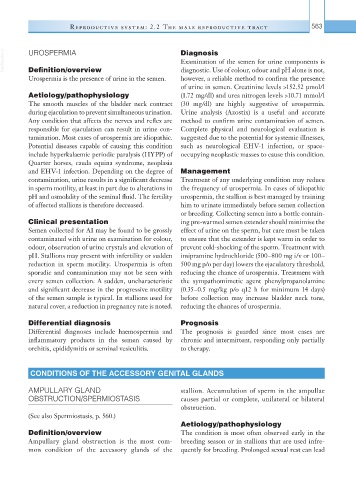Page 588 - Equine Clinical Medicine, Surgery and Reproduction, 2nd Edition
P. 588
Reproductive system: 2.2 The male reproductive tr act 563
VetBooks.ir UROSPERMIA Diagnosis
Examination of the semen for urine components is
Definition/overview
Urospermia is the presence of urine in the semen. diagnostic. Use of colour, odour and pH alone is not,
however, a reliable method to confirm the presence
of urine in semen. Creatinine levels >152.52 μmol/l
Aetiology/pathophysiology (1.72 mg/dl) and urea nitrogen levels >10.71 mmol/l
The smooth muscles of the bladder neck contract (30 mg/dl) are highly suggestive of urospermia.
during ejaculation to prevent simultaneous urination. Urine analysis (Azostix) is a useful and accurate
Any condition that affects the nerves and reflex arc method to confirm urine contamination of semen.
responsible for ejaculation can result in urine con- Complete physical and neurological evaluation is
tamination. Most cases of urospermia are idiopathic. suggested due to the potential for systemic illnesses,
Potential diseases capable of causing this condition such as neurological EHV-1 infection, or space-
include hyperkalaemic periodic paralysis (HYPP) of occupying neoplastic masses to cause this condition.
Quarter horses, cauda equina syndrome, neoplasia
and EHV-1 infection. Depending on the degree of Management
contamination, urine results in a significant decrease Treatment of any underlying condition may reduce
in sperm motility, at least in part due to alterations in the frequency of urospermia. In cases of idiopathic
pH and osmolality of the seminal fluid. The fertility urospermia, the stallion is best managed by training
of affected stallions is therefore decreased. him to urinate immediately before semen collection
or breeding. Collecting semen into a bottle contain-
Clinical presentation ing pre-warmed semen extender should minimise the
Semen collected for AI may be found to be grossly effect of urine on the sperm, but care must be taken
contaminated with urine on examination for colour, to ensure that the extender is kept warm in order to
odour, observation of urine crystals and elevation of prevent cold-shocking of the sperm. Treatment with
pH. Stallions may present with infertility or sudden imipramine hydrochloride (500–800 mg i/v or 100–
reduction in sperm motility. Urospermia is often 500 mg p/o per day) lowers the ejaculatory threshold,
sporadic and contamination may not be seen with reducing the chance of urospermia. Treatment with
every semen collection. A sudden, uncharacteristic the sympathomimetic agent phenylpropanolamine
and significant decrease in the progressive motility (0.35–0.5 mg/kg p/o q12 h for minimum 14 days)
of the semen sample is typical. In stallions used for before collection may increase bladder neck tone,
natural cover, a reduction in pregnancy rate is noted. reducing the chances of urospermia.
Differential diagnosis Prognosis
Differential diagnoses include haemospermia and The prognosis is guarded since most cases are
inflammatory products in the semen caused by chronic and intermittent, responding only partially
orchitis, epididymitis or seminal vesiculitis. to therapy.
CONDITIONS OF THE ACCESSORY GENITAL GLANDS
AMPULLARY GLAND stallion. Accumulation of sperm in the ampullae
OBSTRUCTION/SPERMIOSTASIS causes partial or complete, unilateral or bilateral
obstruction.
(See also Spermiostasis, p. 560.)
Aetiology/pathophysiology
Definition/overview The condition is most often observed early in the
Ampullary gland obstruction is the most com- breeding season or in stallions that are used infre-
mon condition of the accessory glands of the quently for breeding. Prolonged sexual rest can lead

